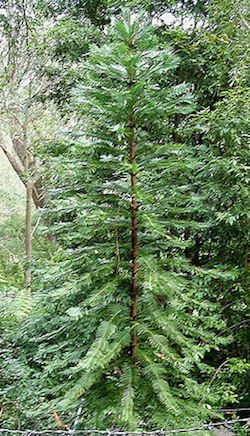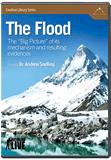
How Did Plants Survive the Flood?
Abstract
Many critics of the Genesis account of history scoff at the idea of plants and seeds lasting for a year in fresh and salt water, therefore discounting the biblical account of the Flood, even though simple and elegant explanations abound. This article will serve as a synopsis of several of those. So really the heart of the matter becomes whether or not one is willing to accept the scriptural account of the Flood and these plausible or even probable explanations for the difficulties they encounter.
Introduction
Even if all the data point to an intelligent designer, such an hypothesis is excluded from science because it is not naturalistic.1
Skeptics love to look for any sort of issue, contradiction, inconsistency, or disagreeable statement in Scripture that suits their agenda to undermine the Scriptures. But these so-called issues are often due to misunderstandings of what the Bible says, incorrect starting assumptions, or wishful thinking. Furthermore, Christian and non-Christian skeptics often do not accept plain, logical explanations.
For instance, when God created vegetation, He created it perfect, so it would have been beautiful, vibrant with color, sturdy and strong, with the possibility of built-in survival mechanisms to withstand harsh conditions. These built-in survival mechanisms could have been present when they were created (or perhaps even introduced after the Fall, a topic beyond the scope of this article). But this simple explanation is usually not enough for skeptics, since they draw from false presuppositions. Even though it is only the Holy Spirit who can remove their blinders so they see the truth, it is still our duty as Christians to give them a reasonable explanation to this question.
Elementary logic, my dear water lily
How could any plants or seeds survive in water for an entire year? What did the plant-eating animals eat after getting off the Ark? These questions are often asked both by skeptics of the Bible and Christians alike. Unfortunately, this sometimes causes believers to doubt God’s Word and accept man’s ideas. As we will see in this article, ways in which plants and seeds survived being water-logged are straightforward and numerous. It will also be worth noting some misunderstandings about what the Bible actually tells us about the duration of the many stages of the Flood.
First, we know God’s Word is true and there was a global Flood. Knowing the Flood happened, and in light of the fact that we have plants today, the important question is: in what ways did the plants and seeds survive the Flood? The logical argument for the fact that plants survived the Flood is actually quite simple.
The Bible states there was a worldwide Flood.
We see plants today.
Therefore plants survived the Flood.
Someone’s poorly researched and unsubstantiated claims should not be cause for doubt, but this does not mean that when people ask these questions they should be dismissed immediately. The real issue is a matter of the heart, and so the proper answer needs to be given in a loving manner (1 Peter 3:15).
Tiiiiiiiiiime . . . is on our side
According to the Flood timeline (see below), it is worth noting that the earth was not completely covered for the entire Flood year. The longest possible amount of time that seeds/plants would have been in or under water, without any contact with land, is 278 days (about nine months and one week). We see from Scripture that the opening of the fountains of the great deep and the windows of heaven were the beginning of the Flood, and that the first indication of plant life returning is the olive leaf that was brought back by the dove (Genesis 8:10–11). More details about the Flood timeline can be seen in Table 1 and Figure 1. So instead of seeds or plants needing to survive for an entire year under water, they would have only had to endure water for a maximum of just over nine months. The period of time was possibly shorter (see table and figure below) since it would have taken many weeks for the entire earth to be covered (including the high hills and mountains), and then some land would have been present long enough for the olive plant to have grown and produced leaves. So this time span could probably be shortened to six or seven months.

Figure 1. Flood timeline graph
Feelin’ salty?!
Something else to be addressed is the ocean’s salinity. Current estimates put it at an average of 35 ppt (parts per thousand; i.e., 35 grams of salt per 1,000 grams of water), whereas freshwater is less than 0.5 ppt. Skeptics assume that it has taken millions and billions of years for the ocean to become this salty based on current rates. They presume the current salinity to be about the same as at the time of the Flood, since it happened around 4,400 years ago. But this is an unfounded assumption as Dr. Russell Humphreys has pointed out,
Every year, rivers and other sources dump over 450 million tons of sodium into the ocean. Only 27% of this sodium manages to get back out of the sea each year. As far as anyone knows, the remainder simply accumulates in the ocean. If the sea had no sodium to start with, it would have accumulated its present amount in less than 42 million years at today’s input and output rates. This is much less than the evolutionary age of the ocean, three billion years (emphasis original).2
There is more than one feasible scenario for the salinity of the ocean, but what follows is the most likely. First, it is possible that the water had salinity similar to that of freshwater before the Flood. Second, it is possible there was a lower salt concentration, similar to brackish water (0.5-30 ppt), during most of the Flood, and that the current salinity is a result of floodwater runoff from the continents, volcanism, and current deposition from rain and rivers. It is not likely the salinity was roughly the same during the inundation stages of the Flood as it is now. But even if it was, it would still not have been a problem for plants to survive. The main point is that skeptics cannot arbitrarily assume the floodwater salinity, since they were not there to measure it. Remember, the ultimate goal of most skeptics is to undermine the Scriptures. So the possibility is left open that the salinity of the floodwaters could have been much less than the ocean’s current salinity.
Survivor! Plant style

Wollemi Pine, credit Amanda Slater via Wikimedia Commons
Another assumption skeptics make is that the species we have today are the same as at the time of the Flood. Though some species were probably around then, like the Wollemi Pine, it is safe to assume that most species around today are not exactly the same as what was around before the Flood 4,400 years ago. Why is this significant? One big reason is that plants today have undergone 4,400 years of speciation, mutations, and genetic deterioration. This must mean some of the genetic information has been lost. Although many would consider species today to be as delicate as species 4,400 years ago, the fact is that those same species could have been more genetically and physically robust, and thus better able to withstand extreme conditions than modern plants, including up to nine months immersed in or floating on open floodwaters!
Oh let me count the ways . . .
We know for certain that plants and seeds did survive the Flood; however, we don’t know exactly all the ways they survived. Not knowing how each survived does not mean they did not or could not. So let’s consider several hypothetical possibilities for plants and seeds survival during the Flood. Many of these possibilities have been documented. For instance, even though Darwin is often synonymous with molecules-to-man evolution, he was a very astute, observational scientist, even though he did not have a biology degree. Both he and George F. Howe (separately) performed experiments to determine whether seeds could survive being soaked in saltwater and how they could be transported over long distances by water. So even the studies of the father of seed-to-simian evolution have provided insight into how some plants and seeds could have survived during the Flood.
The Bible indicates that as the Flood waters receded, plants had already started regrowing.
The Bible indicates that as the Flood waters receded, plants had already started regrowing; evidenced by the dove that returned with an olive leaf (Genesis 8:10–11). This happened at approximately Day 278 of the Flood event; 128 days after the Ark came to rest on one of the mountains of Ararat; giving plenty of time for plants to start taking root and regrow. Howe discovered that even after 140 days of soaking, the seeds of wild flowering plant types were still viable enough to germinate.3,4
Another way plants would have survived is that they were taken onto the Ark as food for Noah, his family, and the animals (Genesis 6:21). Some of these plants could have been the cereal plants Howe found were unable to survive a long time immersed in water. Some of these were replanted by Noah and his family after the Flood since we are specifically told he planted a vineyard (Genesis 9:20). After leaving the Ark any seeds the animals ingested during their final days on the Ark could have passed through and then left on the ground in the animals’ excrement.
Many plants and seeds could have survived on vegetation-mats of floating debris.5 Floating vegetation could have contained many uprooted trees and other plants that could have survived and then regrown once the Floodwaters receded (think, for example, water sprouts). The olive and many other trees and plants are propagated, even today, by asexual budding from planted cuttings. So some seeds could have survived in this debris and their root systems just as Charles Darwin observed, “. . . out of one small portion of the earth thus completely enclosed in by the roots of an oak about 50 years old, three dicotyledonous plants germinated. . . .”6
Many herbivorous animals died in the Flood and their carcasses could have floated as carrion on the surface of the waters holding and protecting seeds in their bodies. Once again, Darwin made an astute observation: “Again, I can show that the carcasses of birds, when floating on the sea, sometimes escape being immediately devoured: and many kinds of seeds in the crops of floating birds long retain their vitality. . . but some taken out of the crop of a pigeon, which had floated on artificial sea-water for 30 days, to my surprise nearly all germinated.”7
Conclusion
There is no doubt that plants survived the Flood. The means by which they survived are numerous, but only a few examples are given here. So the skeptics’ claim that, “plants could not have survived the Flood,” is without warrant. Furthermore, by making this claim they inadvertently invalidate some of the studies of Darwin himself. However, the real question becomes: how can any skeptics’ claims (man’s ideas) survive the great flood of logic from God’s Word and common sense? They can’t!
Table 1: Flood Timeline
Day(s) |
Month/Day |
Event |
Passage |
1 |
(600th year of Noah’s life) |
Fountains of the great deep and windows of heaven opened |
Genesis 7:11 |
1–40 |
3rd month, 27th day |
Rain and flood waters continue to rise and lift up Ark |
Genesis 7:12,17 |
1–150 |
7th month, 17th day |
Water prevails on earth |
Genesis 7:24 |
150 |
7th month, 17th day |
Fountains of great deep and floodgates of heaven closed, rain restrained. Water starts to abate from earth and the Ark comes to rest on mountains of Ararat |
Genesis 8:2–4 |
150–224 |
10th month, 1st day |
Waters continued to recede to the 10th month |
Genesis 8:5a |
224 |
10th month, 1st day |
Tops of the mountains could be seen |
Genesis 8:5b |
264 |
11th month, 11th day |
After 40 days Noah sends out raven |
Genesis 8:6, 7 |
271 |
11th month, 18th day |
After 7 days Noah sends out dove and it returns |
Genesis 8:8, 9 |
278 |
11th month, 25th day |
After 7 more days Noah sends out dove again and it returns with olive leaf |
Genesis 8:10, 11 |
285 |
12th month, 2nd day |
After 7 more days Noah releases dove and it does not return |
Genesis 8:12 |
314 |
601st year |
The surface of the earth was dry |
Genesis 8:13 |
370 |
2nd month, 27th day |
The earth was dried out and Noah and his family and the animals leave the Ark |
Genesis 8:14, 15–19 |
Footnotes
- Scott C. Todd, correspondence to Nature 401 (1999): 423.
- Russell Humphreys, “Evidence for a Young World,” First published in Impact #384 (2005), ICR.
- George F. Howe, “Seed Germination, Sea Water, and Plant Survival in the Great Flood,” Creation Research Society Quarterly 5 (1968): 105–112.
- John Woodmorappe, Noah’s Ark: A Feasibility Study (Dallas, Texas: Institute for Creation Research, 2003), p. 155.
- The possibility of floating vegetation mats on the Floodwaters coincides with the huge quantities of vegetation buried in coal beds, which formed during sediment deposition after the Flood event began.
- Charles Darwin, The Origin of Species, Chapter XII, “Geographical Distribution,” subsection “Means of Dispersal” for Darwin’s salt-water studies. (New York: Signet Mass Market Paperback, original published 1859), p. 349.
- Ibid.
Recommended Resources

Answers in Genesis is an apologetics ministry, dedicated to helping Christians defend their faith and proclaim the good news of Jesus Christ.
- Customer Service 800.778.3390
- © 2024 Answers in Genesis





